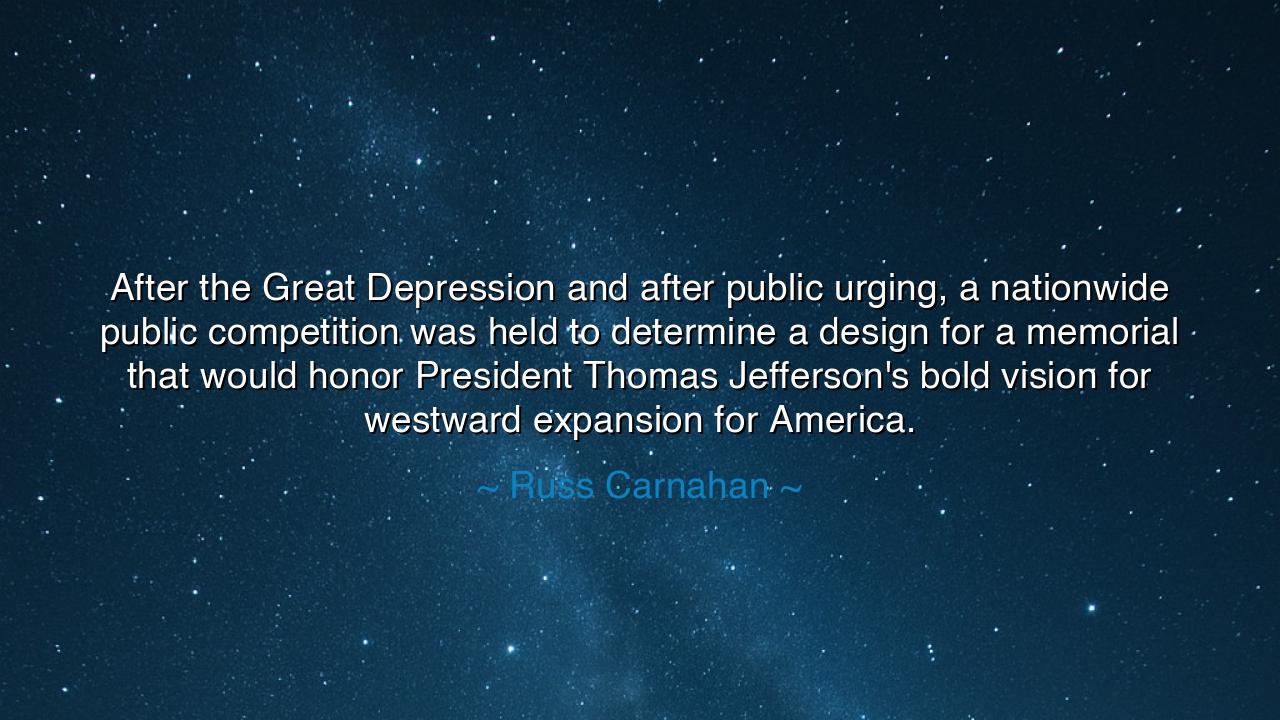
After the Great Depression and after public urging, a nationwide
After the Great Depression and after public urging, a nationwide public competition was held to determine a design for a memorial that would honor President Thomas Jefferson's bold vision for westward expansion for America.






“After the Great Depression and after public urging, a nationwide public competition was held to determine a design for a memorial that would honor President Thomas Jefferson’s bold vision for westward expansion for America.” — Russ Carnahan
Thus spoke Russ Carnahan, a statesman recalling not only the birth of a monument but the renewal of a nation’s spirit. His words are more than a statement of fact — they are a tribute to the power of vision, to the endurance of hope in times of despair, and to the human need to create symbols that outlive sorrow. The Great Depression had cast a long shadow over the land, leaving millions weary and uncertain. Yet from that era of hardship, America turned its eyes again toward the horizon — toward expansion, possibility, and purpose. It was then, as Carnahan reminds us, that the people called for something greater than themselves: a memorial to honor the dream of Thomas Jefferson, who had once imagined a nation stretching “from sea to shining sea.”
The origin of this quote lies in the story of the Gateway Arch, that shining curve of steel that now stands upon the banks of the Mississippi River in St. Louis, Missouri. Conceived in the aftermath of despair, its creation began with a nationwide design competition held in 1947. The people sought not merely to build another monument of stone, but to give form to an idea — to Jefferson’s bold vision of America’s destiny, its faith in progress, and its courage to reach beyond the known. From among hundreds of designs, a young architect named Eero Saarinen submitted a vision both simple and sublime: an arch, rising from the earth, unbroken and eternal, a symbol of the spirit that dares to rise after every fall.
To understand Carnahan’s words is to understand that such a monument was not built from wealth or ease, but from faith renewed. The Great Depression had humbled the nation. Breadlines had replaced abundance, and the optimism of the early century had dimmed beneath hardship. Yet the decision to build a memorial — to honor a man whose dream had once stretched the boundaries of the continent — was itself an act of defiance against despair. It said: We will remember who we are. We will honor the vision that built this land. We will rise again. Thus, the competition was not only architectural — it was spiritual.
When Saarinen’s design was chosen, few could yet imagine the grandeur it would one day embody. Construction began in 1963, amid a new age of turbulence and transformation. The Gateway Arch, as it came to be called, would rise 630 feet into the sky — a perfect, shimmering curve of stainless steel, visible for miles around. It was a symbol not merely of westward expansion, but of American endurance — proof that the dreams of the past could still guide the hopes of the future. Like Jefferson himself, it was a monument to vision: bold, elegant, and free.
And yet, as Carnahan’s quote reminds us, it began not with a government decree, but with public urging — with the people’s voice. Out of the collective will of a nation weary from struggle, there came a cry to build, to remember, to aspire. It was democracy itself made visible, a nation’s creative power united by reverence for its own story. The people who had once known poverty now gave rise to a structure of pure beauty — a testament that even after ruin, humanity’s instinct is to create. For in creation, there is redemption.
There is wisdom here for every generation. When darkness seems endless, when the world feels broken and progress halted, remember this: out of despair, the most enduring dreams are born. The people of the Depression did not build monuments to grief, but to greatness. They honored a man, yes — Jefferson, the philosopher of freedom and architect of expansion — but more than that, they honored the idea that the future is always possible. The Arch, born of competition and cooperation, stands as proof that when vision is married to courage, even a wounded nation can rise toward the heavens.
So, O children of the present age, take heed of this teaching: when your time is marked by difficulty, do not turn away from vision. Look to the builders who came before you — those who, in the ashes of the Great Depression, dreamed not of survival alone, but of beauty, meaning, and progress. Seek your own “arch” — your own act of creation that transforms hardship into hope. For as Russ Carnahan reminds us, history honors not those who merely endure, but those who dare to dream anew — who see beyond the ruins of the moment to the boundless horizon of what may yet be.
And when the storms pass, as they always do, your creations — like the Gateway Arch — will stand as silent witnesses to the power of vision, the strength of unity, and the eternal courage of the human spirit.






AAdministratorAdministrator
Welcome, honored guests. Please leave a comment, we will respond soon